‘DENIM ‘N LACE’
PEROVSKIA
Got Heat? This Tough Little Beauty Won’t Even Break a Sweat
- Showy, easy care perennial for landscapes
- Thrives in all-day sun and heat
- Cool sky blue flowers appear for months
- Attracts pollinating bees and hummingbirds
- Not typically bothered by deer
- 28-32” tall x 34-38” spread
- Perennial in USDA Zones 4-9
- Pronounced “per-OFF-skee-uh”
If you’ve ever grown Russian sage, you know it can be a beast in the landscape, happy to spill over onto its neighbors and rule the roost. That’s why we are so excited to bring you this newer variety that is as well-behaved as a kid at Sunday school. It is every bit as floriferous as its cousins (if not even more so) but stands tall all season without leaning on anyone. All it asks for is at least 6-8 hours of sun and a little drink during times of drought. This is truly a plant it and forget it kind of perennial!
HOW TO GROW ‘DENIM ‘N LACE’ PEROVSKIA
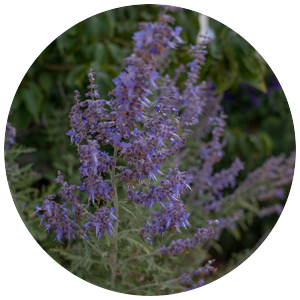
Planting
Look around your landscape to find a relatively dry spot where there is abundant sunshine. That’s where you will want to plant Russian sage. Its tough constitution means it prefers not to be pampered, so save your energy for more needy plants. This one can handle the sun, heat, drought, wind and even salt spray all on its own.
If you’re the kind of person who likes to mix compost and other nutrient-rich ingredients into the soil when planting, know that this perennial will not appreciate that extra step. It will actually grow better in poorer soils that are lacking a high concentration of organic matter. Alkaline soil is preferable, but the only requirement is that the soil be well-drained. This plant’s roots do not like to sit wet for long, especially in winter.
Choose a location that receives abundant sunshine—a minimum of 6-8 hours per day. Russian sage does not need any shade, even in warm climates. Too much shade, too much water, or too rich soil can cause it to stretch and lean.
Plant Russian sage in the spring to give its dense, woody root system time to establish before winter arrives. If planting later in the season, lay a 2-3” layer of mulch around the base of the plant to protect its roots that first season.
If the roots are densely circled around when you take the plant out of the pot, loosen them up a bit to break the “root memory”. This will encourage them to grow outward instead of continuing to grow in a circular pattern.
Set the plant in the hole, making sure that the top of the rootball is level with the top of the surrounding soil. Then backfill the hole with the soil you dug out. Press it down with your hand firmly to eliminate any big air pockets around the roots.
Lastly, water the plant to help the soil settle. The first season while it is getting established, it will need a little more water than in subsequent years. Once its roots are anchored in, they will be able to seek the available moisture from the soil, making the plant self-sufficient.
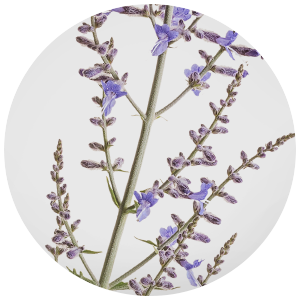
Maintenance
Once you have Russian sage planted in the right place, very little care is required. This truly is a low maintenance perennial.
The most important thing to remember about caring for this plant is not to give it too much love. Overwatering or overfeeding can lead to its demise. If your plant is yellowing, stretching or flopping, it is likely getting too many nutrients, not enough sun, or too much water.
In spring, watch the buds start to swell on its woody stems. When it’s obvious which parts of the plant are showing new growth and which aren’t, it’s time to prune. If no new leaves appear near the tops of the stems, cut them back to the first green bud. Stems that aren’t showing any new growth can be removed completely.
If you are gardening in heavy clay and want to continually improve the soil texture, add a 1-2” layer of compost around the base of the plant every spring. Take care not to bury the crown when you add the new soil. It will provide all the necessary nutrients for the season; no other plant food is needed.
Leave your Russian sage plant standing in fall (do not trim it back), then prune as described above in spring once the new growth appears.
Because of its aromatic foliage and woody stems, few pests, including deer, ever bother Russian sage.

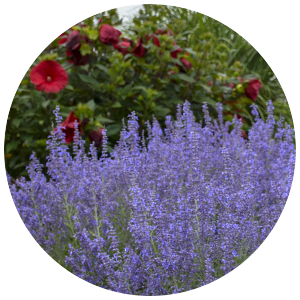
Companion plants
When you are deciding what to plant with your new Russian sage, look first for plants that enjoy similar growing conditions—namely, plants that prefer full sun, lower moisture levels and lean soil.
Since ‘Denim ‘n Lace’ blooms from midsummer into early fall, you could choose to plant it with earlier blooming perennials like ‘Cat’s Pajamas’ catmint, Color Spires® salvia or ‘Midnight Masquerade’ penstemon. They will provide color earlier in the season and look beautiful with the silvery green foliage of the Russian sage in the background.
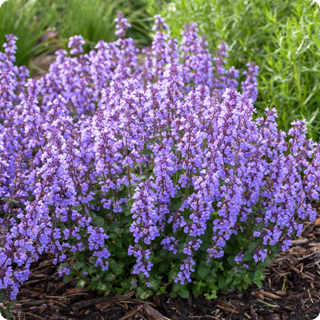
‘Cat’s Pajamas’ Nepeta
If you want to create a blast of color all at once, plant ‘Denim ‘n Lace’ with other perennials that bloom around the same time like Color Coded™ coneflowers, Pyromania™ red hot pokers and Rock ‘n Grow® sedums.
To really make the sky blue flowers of ‘Denim ‘n Lace’ pop, you’ll want to plant something taller in contrasting color behind it. Yellows and purples are especially pretty with Russian sage. You might like it with the gold-leaved Sunshine Blue® II bluebeard, Kodiak® Black diervilla or Summer Wine® ninebark.
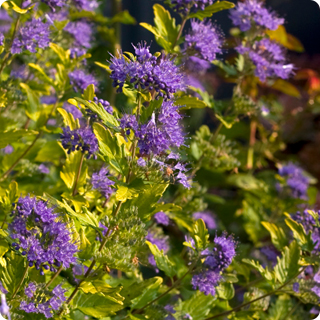
Sunshine Blue® II Bluebeard Caryopteris
top 3 reasons to grow
‘DENIM ‘N LACE’ PEROVSKIA
So much color for so little effort
With almost no care, this perennial blooms its pretty little head off for months beginning in midsummer.
SUPPORT LOCAL POLLINATORS
Nearly every day, you will find pollinating bees and maybe a hummingbird or two stopping by these flowers for a midday snack.
IT KNOWS HOW TO BEHAVE
Unlike older Russian sages, ‘Denim ‘n Lace’ won’t flop onto its neighbors or use up too much real estate in the garden.
Love the look of ‘Denim ‘n Lace’ Perovskia? Look for it at your local garden center, or Shop Online.
‘Denim ‘n Lace’ Perovskia atriplicifolia USPP28445 Can5568

